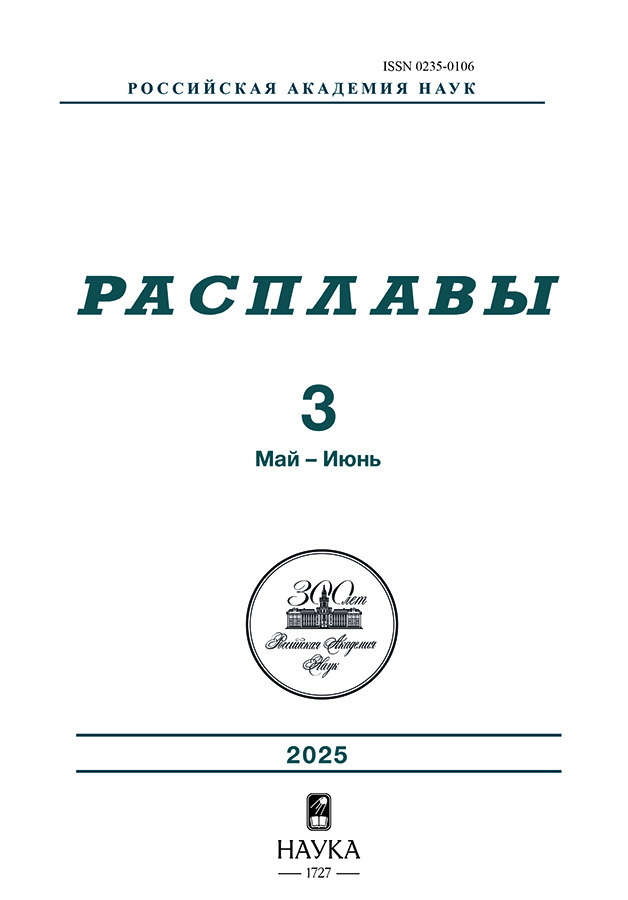Structure and thermal properties of the glass-forming system Na2O – Al2O3 – P2O5
- Authors: Zakiryanov D.O.1, Vlasov M.I.1
-
Affiliations:
- The Institute of High Temperature Electrochemistry of the Ural Branch of the Russian Academy of Sciences
- Issue: No 3 (2025)
- Pages: 192-204
- Section: Articles
- URL: https://ruspoj.com/0235-0106/article/view/686291
- DOI: https://doi.org/10.31857/S0235010625030024
- ID: 686291
Cite item
Abstract
Phosphate glasses can be used as immobilization matrices for radioactive waste. To choose the most suitable compositions for this purpose, it is important to observe data on both the glass structure and physicochemical properties. In the present work, the classical molecular dynamics method was used to evaluate a number of physicochemical properties of Na2O – Al2O3 – P2O5 glass with a mass fractions 0.25 – 0.25 – 0.5, respectively, which is considering as a base glass for complex immobilization matrices. The model system was smoothly cooled from the melt at T = 2300 K down to room temperature. During cooling, the temperature dependences of the density and heat capacity were obtained. According to the calculation, the specific heat capacity of the glass at room temperature is 1.17 J/(g*K). The calculated the radial distribution functions and time dependences of the mean squared ion displacements show that the ensemble at room temperature is in a glassy state. A detailed analysis of the local structure, including the statistics of local environments [MeOn], was carried out. The glass is shown to contain [PO4] tetrahedra combined with [AlO5] and [AlO6], as well as various sodium groupings. The maxima of the radial distribution functions of P-O, Al-O and Na-O lie at 1.50, 2.02 and 2.45 Å, respectively, which is in good agreement with the reference data on the structure of glasses with similar compositions. In addition, the density of 2.526 g/cm3 calculated for room temperature is within the range of typical densities of phosphate glasses and matches the experimentally measured value. For the room-temperature glass, the vibrational densities of states are calculated. The characteristic vibrational frequencies of aluminum and phosphorus are in the regions of 450 cm-1 and 1300 cm-1, respectively, which agree with the experimental Raman spectra semi-quantitatively. To calculate thermal conductivity, nonequilibrium molecular dynamics was used, where the heat flux was simulated in the cell and the temperature gradient was recording. The calculated thermal conductivity and thermal diffusivity are equal to 1.35 W/(m*K) and 4.57*10–7 m2/s, respectively.
Full Text
About the authors
D. O. Zakiryanov
The Institute of High Temperature Electrochemistry of the Ural Branch of the Russian Academy of Sciences
Author for correspondence.
Email: dmitryz.ihte@gmail.com
Russian Federation, Ekaterinburg
M. I. Vlasov
The Institute of High Temperature Electrochemistry of the Ural Branch of the Russian Academy of Sciences
Email: dmitryz.ihte@gmail.com
Russian Federation, Ekaterinburg
References
- Sengupta P. // J. Hazard. Mater. 2012. 235-236. P. 17–28. https://doi.org/10.1016/j.jhazmat.2012.07.039
- Oelkers E.H., Montel J.-M. // Elements. 2008. 4(2). P. 113–116. https://doi.org/10.2113/gselements.4.2.113
- Musatov N.D., Kashcheev V.A., Tuchkova A.I. i dr. // Vopr. atom. nauki i tekh. 2020. № 1 (102). P. 66–75.
- Vlasov M.I., Vedernikova E.D., Pershina S.V. i dr. // Steklo i keramika. 2025. 98(1), P. 03–16.
- Brow R.K. // J. Non-Cryst. Solids. 2000. 263-264. P. 1–28. https://doi.org/10.1016/s0022-3093(99)00620-1
- Zielniok D., Cramer C., Eckert H. // Chem. Mater. 2007. 19. P. 3162–3170. https://doi.org/10.1021/cm0628092
- Balyakin I.A., Vlasov M.I., Pershina S.V., Tsymbarenko D.M., Rempel A.A. // Comput. Mater. Sci. 2024. 239. P. 112979. https://doi.org/10.1016/j.commatsci.2024.112979
- Muñoz F., Rocherullé J., Ahmed I., Hu L. Springer Handbook of Glass. Springer. 2019. P. 553–594
- Muñoz F., Montagne L., Pascual L., Durán A. // J. Non-Cryst. Solids. 2009. 355. P. 2571–2577. https://doi.org/10.1016/j.jnoncrysol.2009.09.013.
- Grest G.S., Cohen M.H. // Phys. Rev. B. 1980. 21. P. 4113–4117. https://doi.org/10.1103/physrevb.21.4113
- Hoppe U., Walter G., Kranold R., Stachel D. // J. Non-Cryst. Solids. 2000. 263-264. P. 29–47. https://doi.org/10.1016/s0022-3093(99)00621-3
- Liu H., Zhao Z., Zhou Q. et al. // C. r., Géosci. 2022. 354(S1). P. 35–77. https://doi.org/10.5802/crgeos.116
- Jahn S. // Rev. Mineral. Geochem. 2022. 87(1). P. 193–227. https://doi.org/10.2138/rmg.2022.87.05
- Pedone A // J. Phys. Chem. C. 2009. 113(49). P. 20773–20784. https://doi.org/10.1021/jp9071263
- Buckingham R.A. // Proc. R. Soc. Lond. 1938. 168(933). P. 264–283. https://doi.org/10.1098/rspa.1938.0173
- Al-Hasni B., Mountjoy G. // J. Non-Cryst. Solids. 2010. 357(15). P. 2775–2779. https://doi.org/10.1016/j.jnoncrysol.2010.10.010
- Du J., Cormack A.N. // J. Non-Cryst. Solids. 2004. 349. P. 66–79. https://doi.org/10.1016/j.jnoncrysol.2004.08.264
- Lv X., Xu Z., Li J., Chen J., Liu Q. // J. Mol. Liq. 2016. 221. P. 26–32. https://doi.org/10.1016/j.molliq.2016.05.064
- Zakiryanov D., Kobelev M., Tkachev N. // Fluid Ph. Equilib. 2019. 506. P. 112369. https://doi.org/10.1016/j.fluid.2019.112369
- Thompson A.P., Aktulga H.M., Berger R. et al. // Comput. Phys. Commun. 2021. 271. P. 108171. https://doi.org/10.1016/j.cpc.2021.108171
- Thomas M., Brehm M., Fligg R., Vöhringer P., Kirchner B. // Phys. Chem. Chem. Phys. 2013. 15(18). P. 6608. https://doi.org/10.1039/c3cp44302g
- Chanshetti U.B., Shelke V.A., Jadhav S.M. et al. // FU Phys Chem Technol. 2011. 9(1). P. 29–36. https://doi.org/10.2298/fupct1101029c
- Brow R.K. // J. Am. Ceram. Soc. 1993. 76(4). P. 919-928. https://doi.org/10.1111/j.1151-2916.1993.tb05315.x
- Alhasni B. // J. Non-Cryst. Solids. 2021. 578. P. 121338. https://doi.org/10.1016/j.jnoncrysol.2021.121338
- Shvanskaya L.V., Yakubovich O.V., Belik V.I. // Crystallogr. Rep. 2016. 61. P. 786–795. https://doi.org/10.1134/s1063774516050205
- Hoppe U. // J. Non-Cryst. Solids. 1996. 195. P. 138–147. https://doi.org/10.1016/0022-3093(95)00524-2
- Schneider J., Oliveira S.L., Nunes L.A.O., Panepucci H. // J. Am. Ceram. Soc. 2003. 86. P. 317–324. https://doi.org/10.1111/j.1151-2916.2003.tb00017.x
- Yadav A.K., Singh P. // RSC Advances. 2015. 5(83). P. 67583–67609. https://doi.org/10.1039/c5ra13043c
- Li W., He D., Li S., Chen W., Hu L. // Ceram. Int. 2014. 40(8). P. 13389–13393. https://doi.org/10.1016/j.ceramint.2014.05.056
- Hudgens J.J., Brow R.K., Tallant, Martin S.W. // J. Non-Cryst. Solids. 1998. 223(1-2). P. 21–31. https://doi.org/10.1016/s0022-3093(97)00347-5
- Boucher S., Piwowarczyk J., Marzke R.F. et al. // J. Europ. Ceram. Soc. 2005. 25. P. 1333–1340. https://doi.org/10.1016/j.jeurceramsoc.2005.01.016
- Goj P., Handke B., Stoch P. // Sci. Rep. 2022. 12. P. 17495. https://doi.org/10.1038/s41598-022-22432-5
- Freitas A.M., Bell M.J.V., Anjos V. et al. J. Lumin. 2015. 169. P. 353–358. https://doi.org/10.1016/j.jlumin.2015.08.062
Supplementary files

















